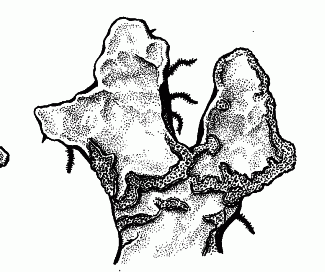Parmelia sulcata Taylor
Hammered crottle
Parmeliaceae
Introduction to the Lichens
Hammered crottle
Parmeliaceae
Introduction to the Lichens
Map
Distribution of Parmelia sulcata unavailable
Species Information
General:
Medium stratified foliose lichens, corticate above and below, sorediate or isidiate or not, checkered pseudocyphellate (in BC), lobes loosely attached to rather closely appressed, elongate, averaging to 1.5–10 mm wide, thin. Upper surface whitish or pale greyish blue, somewhat shiny. Lower surface blackening, shiny, bearing short or rather long, simple or branched rhizines. Medulla white. Photobiont green. Apothecia located over upper surface, disc brown; spores simple, ellipsoid, colourless, 8 per ascus. Over rock and trees.
Notes: Parmelia is primarily a boreal and temperate genus consisting of 39 species worldwide. Eight of these are reported for North America and seven occur in B.C. As originally circumscribed by Acharius in 1803, Parmelia encompassed an enormous assemblage of foliose lichens, including Lobaria, Pannaria and Xanthoria. Beginning in the latter half of the 19th century, and apparently concluding only in the past decade, lichenologists have divided Parmelia into dozens of new genera, most of which are now widely accepted. Local species accommodated until recently in Parmelia are now dispersed among the following genera: Ahtiana, Arctoparmelia, Flavopunctelia, Hypotrachyna, Melanelia, Neofuscelia, Punctelia, and Xanthoparmelia.
Species description:
Soredia and/or isidia present (rarely sparse); ecology various AND Thallus sorediate; soredia dull, confined to discrete soralia
Reactions:
Cortex K+ yellow, medulla K+ yellow becoming red, PD+ orange.
Contents:
Atranorin and salazinic acid.
Source: Lichens of British Columbia
Illustration

If more than one illustration is available for a species (e.g., separate illustrations were provided for two subspecies) then links to the separate images will be provided below. Note that individual subspecies or varietal illustrations are not always available.
Illustration By: Trevor Goward
Habitat and Range
Habitat: Common over trees throughout, also infrequent over acid rockWorld Distribution: circumpolar, N to AK, S to CA.
Source: Lichens of British Columbia